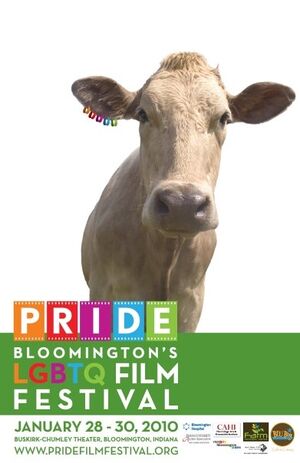Difference between revisions of "Bloomington Pride Film Festival"
(New page: The Bloomington Pride Film Festival began as a class project in 2003, as a one-day event showing ten films. The film list doubled, from ten to twenty-one, between 2004 and 2005, and the ...) |
|||
| Line 1: | Line 1: | ||
| − | The Bloomington Pride Film Festival began as a class project in 2003, as a one-day event showing ten films. | + | The Bloomington Pride Film Festival began as a class project in 2003, as a one-day event showing ten films. [[Image:steerqueer.jpg|thumb|The 2010 promotional poster for the Pride Film Festival]] |
The film list doubled, from ten to twenty-one, between 2004 and 2005, and the festival became a two-day event. The 2005 film festival also saw the introduction of a post-festival party at the festival venue, the Buskirk-Chumley Theater near the Bloomington town square. | The film list doubled, from ten to twenty-one, between 2004 and 2005, and the festival became a two-day event. The 2005 film festival also saw the introduction of a post-festival party at the festival venue, the Buskirk-Chumley Theater near the Bloomington town square. | ||
| − | The film festival's size doubled yet again between 2005 and 2006, with four days worth of | + | The film festival's size doubled yet again between 2005 and 2006, with four days worth of activities planned and almost 40 films on the roster. The 2006 festival also saw the introduction of more full-length films, and a significantly increased number of documentaries, in addition to further inclusion of trans, bi, and lesbian-themed pieces. 2006 also saw the festival after-party moved to the end of the Saturday showings, after the success of the 2005 celebration. |
The 2010 incarnation of the event featured the theme "Steer Queer!", and showed films with a focus on rural queerness. This particular theme resonates with the queer community of Monroe County, which is itself largely rural. The film has grown to become a major centerpiece of queer celebration in Bloomington and the surrounding area; in 2008, combined ticket sales to the various festival-related events topped 2,000. | The 2010 incarnation of the event featured the theme "Steer Queer!", and showed films with a focus on rural queerness. This particular theme resonates with the queer community of Monroe County, which is itself largely rural. The film has grown to become a major centerpiece of queer celebration in Bloomington and the surrounding area; in 2008, combined ticket sales to the various festival-related events topped 2,000. | ||
Revision as of 22:01, 30 April 2010
The Bloomington Pride Film Festival began as a class project in 2003, as a one-day event showing ten films.
The film list doubled, from ten to twenty-one, between 2004 and 2005, and the festival became a two-day event. The 2005 film festival also saw the introduction of a post-festival party at the festival venue, the Buskirk-Chumley Theater near the Bloomington town square.
The film festival's size doubled yet again between 2005 and 2006, with four days worth of activities planned and almost 40 films on the roster. The 2006 festival also saw the introduction of more full-length films, and a significantly increased number of documentaries, in addition to further inclusion of trans, bi, and lesbian-themed pieces. 2006 also saw the festival after-party moved to the end of the Saturday showings, after the success of the 2005 celebration.
The 2010 incarnation of the event featured the theme "Steer Queer!", and showed films with a focus on rural queerness. This particular theme resonates with the queer community of Monroe County, which is itself largely rural. The film has grown to become a major centerpiece of queer celebration in Bloomington and the surrounding area; in 2008, combined ticket sales to the various festival-related events topped 2,000.
